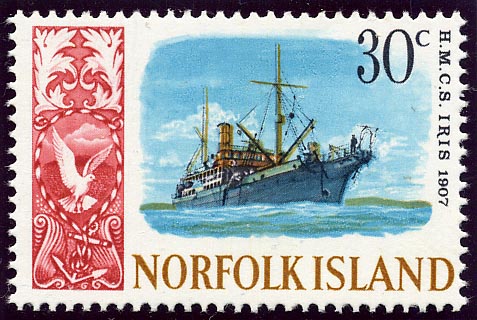
: H.M.C.S. Iris. The Iris is the sixth cable ship, specially built for the job, to appear on stamps; one can hardly include the Leviathan in this category, although she undoubtedly proved more successful in this service than in the work for which she was built. The Iris was built during 1901-02 by D. J. Dunlop on the Clyde, for the Pacific Cable Branch, In 1902 the first section of the Pacific cable was laid from Fanning Island to Suva, Norfolk Island, Australia and New Zealand. The vessel had a long career, being in service exactly half-a century.
One of the most interesting events in the ship's history was in 1917, when she was responsible for the capture of the German captain, Count von Luckner, master of the German sea-raider Seeadler. After he had been interned in the Fiji Islands he made a dramatic escape, taking the commandant's launch, with some of the toughest prisoners, and making out to sea. Three days after the break-out he seized the schooner Moa. After overpowering her crew, he prepared to continue his raiding; off Macauley Island, where he intended to put the Moa's crew ashore, smoke was sighted on the horizon, and he had to run for it, but his luck was out. H.M.C.S. Iris, now with two guns mounted on her decks, had been despatched to find him. The Iris quickly gained on him and he hove to, rather than lose the lives of his men. The Germans were taken to Auckland, where they were imprisoned for the rest of the war.
A new chapter in the career of the Iris began when she was transferred to Imperial and International Communication, Ltd. (now Cable and Wireless, Ltd.) in 1929 and was renamed C.S. Recorder. Her last voyage began in March 1952, when she left Singapore for England, arriving on May 15, 1952 at Plymouth. She was subsequently broken up. The stamp design shows the cable ship hove-to while her crew are hard at work repairing a break in a cable at sea.
SG 88 Sea Breezes 4/68
